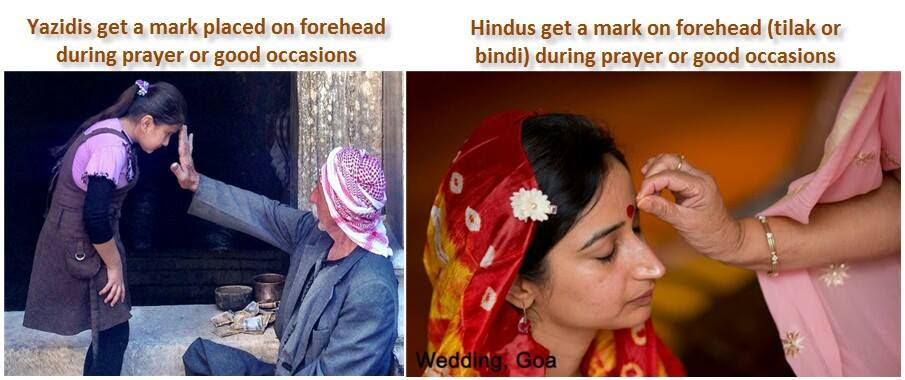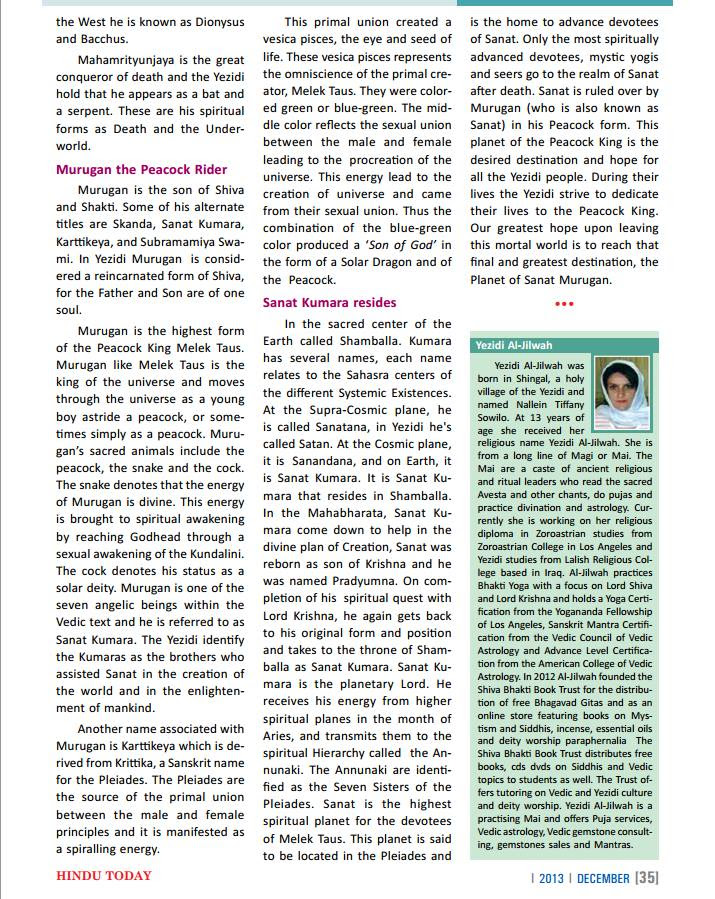About the Authors:
Nallein Satana Al-Jilwah Sowilo. She is from the Srinjar (Shinghal) province in Iraq. Right now she is in Los Angeles , California and teaches Yoga there.More details are there in the last part of the article she had written before. Mr. Vrndavan Brannon Parker Acbsp edited the article and also deserves credit.
Yezidi Sanatan Dharma Society – Yezidis and Non-Resident Indians join hands for the Yezidi Cause
As Prime Minister of India, Sri Narendra Modi meets the Non Resident Indians in New York’s Madison Square Gardens, a group of Indians are spotted canvassing for the Yezidi community in Iraq. Who are the Yezidis and why a bunch of tech savvy Indians are suddenly eager to take up their cause.
The Yezidis are an Aryan people originally from Airyna Vaeja the mystical Homeland of Aryans which is in present day India. The word Aryan is not related to race but refers to ‘The righteous’. The Yezidi calendar is 6764 yrs old and is the oldest in the Middle East. About 5000 years ago Yezidis migrated to Afganistan, Iran, Iraq and Middle East. At that time they were called Children of Melek Taus. Melek is an ancient Semite God of Babel and Caanite. Another spelling in Semite of Melek is Malik. Melek or Malik can be found in Sanskrit word Malaiklavon. Malaiklavon is another name for Murugan/Skanda, a God found in South India.
Airyna Vaeja was an Empire of Aryans which included present day India. It also included Turkministan, Uzbekistan, Afganistan and Meda. Meda was part of Iran (a name rooted in the term Aryan) which is in present day Kurdistan. In the Avesta text and Shahnameh text, the legendary King Jamshid of Airyana Vaeja is mentioned. The name Jamshid is latter version of the name Yima Sira or Yima Khshaeta. Yima means the radiant. In Avesta Jamshid is called Yima, son of Vivanghat. While in the Vedas he is called Yama, son of Vivasvant also known as Surya or the Sun-God.
The Avesta language was named after the Avesta text of Zoroastrians. The language and style of Old Avesta and Rig Veda are so close that they are commonly thought to be different versions of the same language of Sanskrit. The religion of Yezidis share much in common with Vedic Hindus. Yezidi have a Caste system like Hindus. However no caste based discrimination has ever been reported among the Yezidis. Yezidis believe in reincarnation. The Peacock finds a special place in their religion. It is worshiped as Melek taus/Murugan/Skanda/Kartikeya.
The peacock is not native to Iraq or the Middle East but is indigenous to India. The serpent is the totem of Melek Taus/Murugan in Yezidi. Like the Hindu Indian Murugan the serpent symbolizes the Kundalini released. Lord Rama is also one of the Yezidi gods. Exactly like the Hindus the Yezidis use Tilak and place the mark upon their foreheads. Another clue in Yezidi to the location of their homeland lies in mythology of their Holy land called Perani which is derived from word Pazhani, a Temple in Dindigul district of Tamil Nadu. The deity there is Murugan or Kartikeya.
Ref: https://www.facebook.com/photo.php?fbid=775152592544515&set=pcb.623175151132375&type=1&theater
The present crisis represents the 74th attempt at genocide against this ancient people. It began with an attack on Shingal. This is where most of the Yezidi population reside. The latest attack began in May this year when ISIL crossed into Iraq from Syria. The Yezidi tribal leaders were able to fight ISIL in the plains. In the mountains the Yezidis were able to hold up until August when ISIL broke through the mountains killing thousands. Frightened Yezidis fled from the plains to the mountains. ISIL encircled the mountain trapping the Yezidis on the mountain. Thousands died without food or water, children lived for days on the blood of their parents. When people were too weak to flee the mountain and after thousands had died ISIL entered mountains gunning down thousands and thousands of Yezidis. 210,000 died in all. Women who were captured were raped and sold in the marketplace for $10. Swords and knifes were used to decapitate the Yezidis men who had been captured. Most refused to convert to Islam and rather preferred to be beheaded. 500,000 Yezidis are now refugees in Syria. Most are out in the open without any winter wear and winter temperatures reaching sub-zero will soon overwhelm the region. The Yezidi people are not a massive group. Only one million Yezidis are present in Iraq and their survival is crucial for the survival of this ancient civilization.
Following the massacres, the Hindus globally began rallying to the Yezidi cause. The Yezidis under Qasim Shesho has formed an armed resistance group to protect the last surviving Yezidis from ISIL. Recognition for the efforts of the global Hindu community was recently expressed by Qasim Shesho himself speaking from the battlefields of Iraq. In a recently published interview with Zee News, he lauded the Hindus for their tangible support for the Yezidi cause .
In his words,
“I know my future is in danger in Iraq and so is my family’s which is currently in Germany. ISIS has its people in Europe and everywhere in the world. But I would like to thank you and all Hindus… your government because they have shown care for us and have respected us like a family.” – Qasim Shesho
A tangible milestone was reached when Non Resident Indians joined hands with the Non Resident Yezidis to raise $100,000 though SEWA. A representative of YSDS was present during Modiji’s rally at the Madison Square Gardens and the response was encouraging.
These experience in this last three months is reflective of the trust that the Yezidis now place in the Indians . This represents a historic event taking place within our own lifetime and it is unfolding before us. The last of the Dharmic tribes in the Middle East are coming to the Hindu fold. This is the silver lining of hope coming out of the humanitarian tragedy that is the Middle East.







